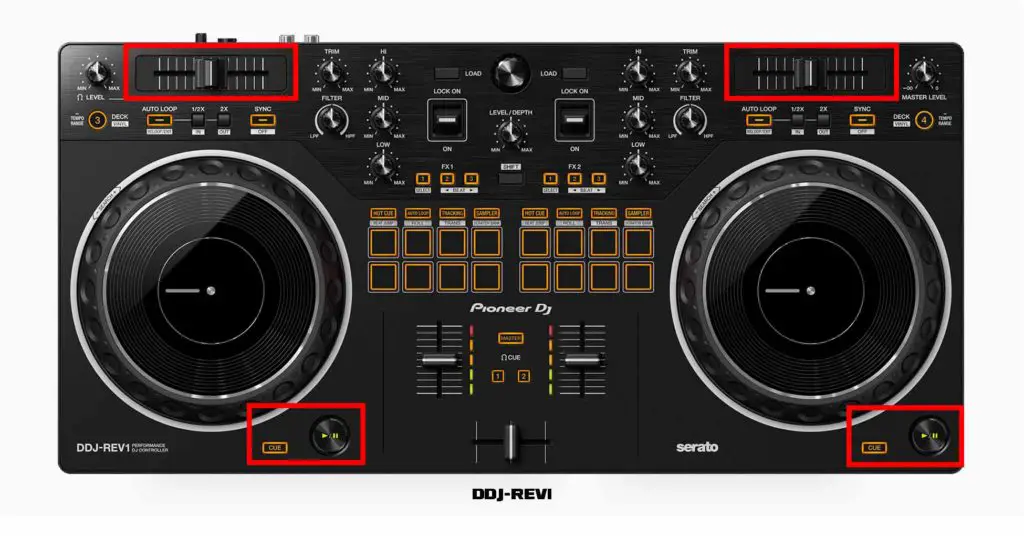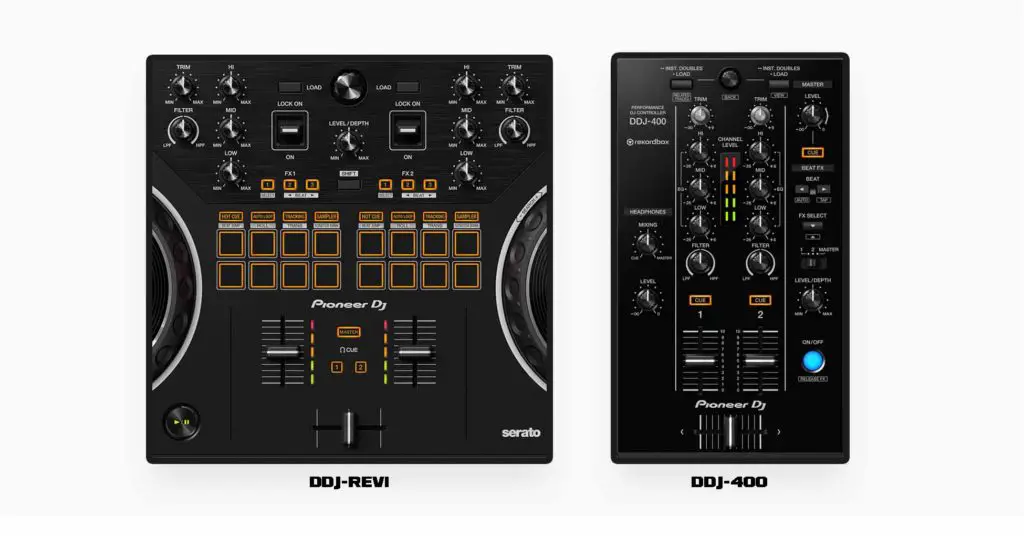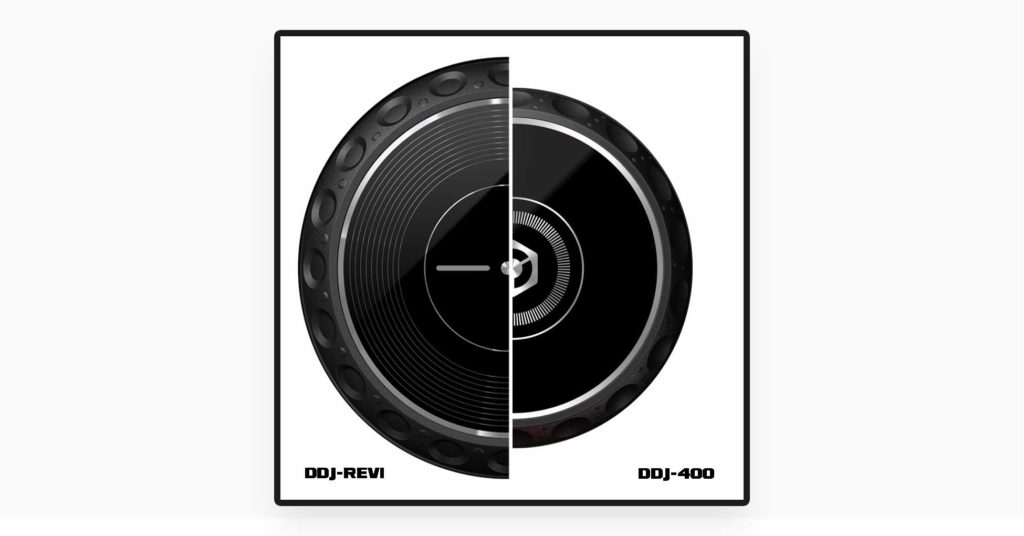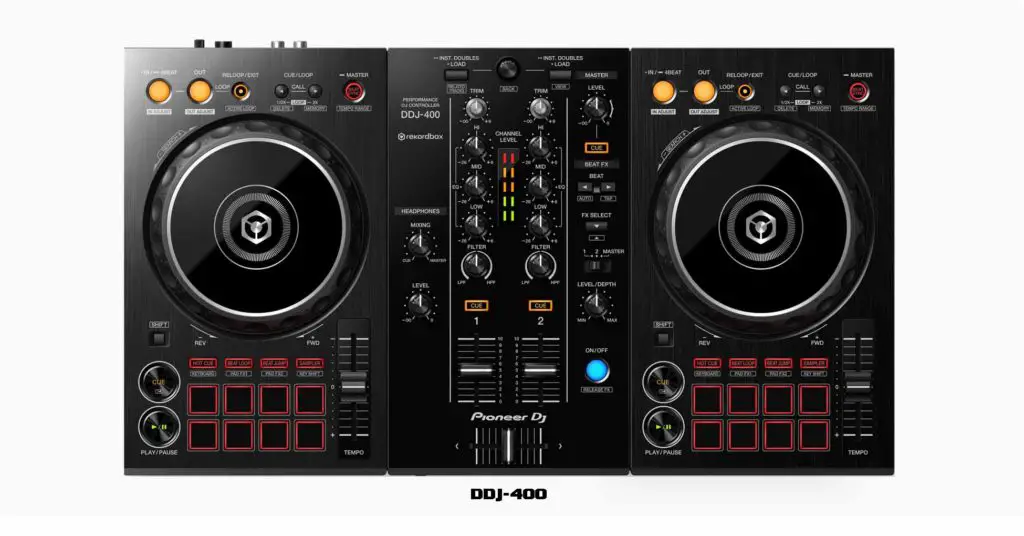Pioneer DDJ-400 vs. DDJ-Rev1 – straight to the point detailed DJ controller comparison. Which one should you get? Which one is better for beginners? What are the main differences between the DDJ-Rev1 and the DDJ-400? Let us answer all these questions now.
If you’re interested in other affordable DJ controllers good both for beginners and more advanced users, check out our extensive article about DJ gear we recommend here: What Equipment Do You Need To DJ?
- Different control layouts
- The mixer sections
- The FX sections
- Performance pads
- Tracking Scratch mode on the DDJ-Rev1
- Jog wheels
- Software compatibility
- Inputs and outputs
- Pros and cons
- The conclusion
Click here to instantly skip straight to the pros and cons summary!
This web portal is supported by its readers, and is a part of the Amazon Services LLC Associates Program and the eBay Partner Network. When you buy using links on our site, we may earn an affiliate commission!

Different control layouts
The key difference between the Pioneer DDJ-Rev1 and the Pioneer DDJ-400 is the control layout used in both of the devices.
The DDJ-400 utilizes a club layout that is based on a setup that is most commonly found in club DJ booths, a setup consisting of two CD players (like the Pioneer CDJ players) and a single audio mixer in between.
The DDJ-Rev1 on the other hand, features a battle style layout, a control layout based on a traditional battle style DJ setup – two vinyl turntables rotated by 90 degrees counterclockwise (with tonearms positioned away from the user) and an audio mixer in between.
More on battle style DJ controller layouts here: What Is A Battle Style DJ Controller Layout? – Quickly Explained

Because of these layout choices, on the DDJ-Rev1 the tempo faders are located on top of each of the deck sections and the play/pause button is placed asymmetrically in the bottom right of the decks.
A cue button which is not present on vinyl turntables the DDJ-Rev1 takes inspiration from, was still added to the device as a complementary button on the left side of the play/pause button.
You can find the performance pads on the DDJ-Rev1 in the middle of the mixer section, rather than under the jog wheels like on the DDJ-400.
On the DDJ-400, the tempo faders are also placed assymetrically, but here they are located on the right side of the performance pads, underneath the jog wheel.
The play/pause button alongside with the cue button are placed on the opposing side of the performance pads.

If you’re just starting out it doesn’t really matter which layout you’ll decide to go with. Generally, the battle style layout is more suite for performance scratch DJs, while the club layout is meant for DJs that plan to mix a lot in club environments, on a full-on CDJ setups.
Choosing one layout over the other will help you to adjust to a similar setup in a possible future, but will definitely not be a factor that will affect your future skills or ability to learn more advanced mixing techniques.
The mixer sections
The mixer section on the DDJ-Rev1 is modeled after a famous line of Pioneer DJM-S mixers generally meant for scratch DJs. It’s a lot wider than the mixer section of the DDJ-400, as it has to contain two sets of performance pads (slightly smaller than these on the DDJ-400) and FX paddles (which the DDJ-400 doesn’t have).
The DDJ-400 has a much narrower mixer section modeled after the Pioneer DJM line of DJ mixers, with a Beat FX strip on the right side and additional headphone control knobs on the left (on the DDJ-Rev1 these knobs are located on a deck rather than on a mixer).

It’s also important to mention that the DDJ-Rev1 doesn’t feature a cue/master headphone regulation knob that the DDJ-400 has. This means that the balance between the master audio and the cue audio in your headphones will have to be adjusted in-software.
The mixer section on the DDJ-Rev1 is much more friendly towards scratch DJs which is not a big surprise, as it’s modeled after a mixer which is essentially meant to be used for scratch performances. The DDJ-400 will generally better suit a club DJ, as its mixer controls closely resemble the Pioneer DJM mixer line which is most commonly used in club environments.
Now its time to talk about the audio FX controls on both the DDJ-Rev1 and the DDJ-400.
The FX sections
The FX control scheme vastly differs between the DDJ-Rev1 and the DDJ-400. On the DDJ-Rev1 you can find two FX paddles and two FX banks with 3 effects on/off buttons, alongside with one level/depth FX parameter control knob.
The DDJ-400 on the other hand, features a single Beat FX strip with an FX select button, FX channel selection switch and a level/depth knob. DDJ-400 also has dedicated buttons for controlling the FX beat division (on the DDJ-Rev1 you can change the beat divisions using FX buttons and the shift button).
The FX paddles on the DDJ-Rev1 can either be activated temporarily in hold mode when pushed down, or toggled permanently when pushed up. When activated, the FX paddles will engage the FX you’ve turned on using the orange FX selection buttons.
On the DDJ-Rev1 you can activate up to 3 FX on each deck at once, while on the DDJ-400 you can only use one effect at the time on either channel 1, 2 or master output.

On the DDJ-400 you can cycle through the software effects using the FX Select button, while on the DDJ-Rev1 you can only change the first effect from the FX bank from the controller. To change the remaining two effects in a bank you’d have to use your laptop.
The DDJ-400 also has an advantage of making use of the Rekordbox Pad Release FX, while the DDJ-Rev1 working under Serato DJ doesn’t give you that option.
Overall the DDJ-Rev1 gives you better FX control and allows you to trigger multiple FX on one channel, while the DDJ-400 has the advantage of highly customizable Pad Release FX in addition to its Beat FX strip effect section.
Performance pads
There are two main differences between the performance pads on the DDJ-400 and the DDJ-Rev1. The first one is the pad size.
While the performance pads look and work in the exact same way on both devices (soft rubbery finish and a click at the end of button travel), their size differs by quite a lot. Performance pads on the DDJ-Rev1 are smaller than these on the DDJ-400, as they had to be crammed in the tight space between the two decks.

Other than that, the 8 performance pad modes also differ between these two devices, the main reason for that being the software differences between Serato DJ and Rekordbox.
DDJ-Rev1 features the following performance pad modes:
- Hot Cue – 4 hot cues available
- Auto Loop – same as Beat Loop on the DDJ-400
- Tracking Scratch – a quasi-auto-scratch feature that controls the crossfader movements while you are only in charge of moving the platter to produce scratch sound patterns.
- Sampler – 4 sample slots available
- Beat Jump (only with Serato DJ Pro) – allows you to jump a set number of beats forwards or backwards while maintaining the track’s tempo synchronization
- Roll (only with Serato DJ Pro) – quick access to multiple short loop values
- Trans – a sound ducking effect with different accessible beat divisions for each pad (8 trans effect patterns available in total)
- Scratch Bank – a feature that allows you to quickly access your custom scratch samples on each deck and then with a press of a button return to the track that was playing before the scratch bank activation
And these are the performance pad modes available on the DDJ-400:
- Hot Cue – 8 hot cues available
- Beat Loop – same as Auto Loop on the DDJ-Rev1
- Beat Jump – same as on the DDJ-Rev1
- Sampler – 8 sample slots available
- Keyboard – allows you to control the pitch of a cue point
- Pad FX 1 – fully customizable Rekordbox pad FX bank #1
- Pad FX 2 – fully customizable Rekordbox pad FX bank #2
- Key Shift – gives you ability to shift the key of a playing track

Tracking Scratch mode on the DDJ-Rev1
The DDJ-Rev1 features a Tracking Scratch mode that can be activated using the performance pads.
When it’s activated, the tracking pad mode will control the crossfader movements for you and return the track to the cue point automatically when you move the jog wheel. It allows you to perform 6 different scratches just by moving the jog wheel in a timely manner, without touching the crossfader. This way you can slowly learn the hand movements necessary for performing each of the available scratch patterns without worrying about the crossfader gymnastics.
This kind of behavior places it above the DDJ-SB3 auto pad scratch feature which automatically performed the whole scratch for you without any room for variations or additional control, and also way above the DDJ-FLX6 jog cutter mode.
Pioneer DDJ-FLX6 – DJ Controller Overview
There are a few crossfader scratch patterns to chose from and you can select each one of these using the performance pads when the tracking mode is active.
Following scratch patterns are available in the tracking mode on the DDJ-Rev1:
- Forward Stab
- Reverse Stab
- Chirp
- Orbit
- Crab
- Stab/Baby Combo
Jog wheels
Both the Pioneer DDJ-Rev1 and the DDJ-400 feature touch sensitive capacitive jog wheels that can be used both for scratching, beatmatching and track position control.
The jog wheels on the DDJ-Rev1 are definitely one of the selling point of this device. They are slightly bigger than these present on both the Pioneer DDJ-400 and the DDJ-SB3 controllers.
We’re talking about 5.20 inches (132 mm) jog wheel diameter on the DDJ-Rev1 vs. 6 inches (154 mm) on both the DDJ-400 and the DDJ-SB3.
Jog wheels on the DDJ-Rev1 are comparable in size to the jog wheels present on controllers such as the DDJ-SX or the DDJ-RX controller series.
The platters on the DDJ-Rev1 and DDJ-400 are not motorized like the ones present on the Pioneer DDJ-Rev7.
Check out also: New Pioneer DDJ-Rev7 – DJ Controller Detailed Review

Other than that, the jog wheels on the DDJ-Rev1 do feel slightly better than these present on the DDJ-400, feature a simple needle indicator and a rubbery perforated edge to allow for comfortable pitch bending. All in all if you’re in for some scratching the DDJ-Rev1 would be a better choice for you.
If you’re curious about cheap entry-level DJ controllers with even bigger jog wheels, be sure to check out our take on the DDJ-FLX6 here: Pioneer DDJ-FLX6 – DJ Controller Overview
Software compatibility
Pioneer DDJ-Rev1 is a Serato DJ controller and it’s only currently officially supported by the Serato DJ Lite software (which it comes bundled with) and the Serato DJ Pro (available as a paid upgrade).
The Serato DJ Pro upgrade allows you to use all of the pad modes on the device and the full Serato DJ software functionality.
The DDJ-400 on the other hand is a dedicated Rekordbox controller and the full Rekordbox software version is available to you from the get go.
If you don’t have any software preferences yet, rest assured that both the Serato DJ and the Rekordbox software are two of the most popular DJ software in the world right now alongside with Traktor and Virtual DJ.
Serato DJ is in general more commonly used by scratch DJs, while the Rekordbox software is more often preferred by club DJs, although both of these provide really similar experience, only with some workflow differences.
All Pioneer DJ Controllers Listed – 10 Years Evolution 2011-2021
Inputs and outputs
Both the Pioneer DDJ-Rev1 and the DDJ-400 have built-in soundcards and feature the exact same inputs and outputs:
| Inputs | 1x microphone input (1/4″ TS Jack) |
|---|---|
| Outputs | 1x master output (RCA), 1x headphones input (1/8″ stereo mini jack) |
| Other | 1x USB B port (for laptop connection and power) |
The only thing that might put both these devices at a slight disadvantage is that both of these feature only a mini jack (3.5mm or 1/8″) headphone outputs.
This means that if you plan to use any kind of professional headphones with an 1/4″ jack cable you will have to use a bulky adapter for that. Other than that, the outputs offered in this price point are perfectly fine.
Other than that, on the DDJ-Rev1 the microphone input is routed through your laptop, that means you are able to easily add the live audio from your microphone to your stream or mix recording without using any additional hardware.
Pros and cons

Pros:
- Battle style layout on an all-in-one DJ controller
- Bigger, sturdier and tighter jog wheels compared to the DDJ-400/DDJ-SB3
- Allows you to control virtual decks 3 and 4
- Microphone input now routed through the laptop
- FX paddles + up to 3 different software FX can be active on one channel
Cons:
- Comes only with Serato DJ Lite, some features soft-locked without the upgrade to Serato DJ Pro
- The headphone output is a 1/8″ (3.5mm) jack so you might need to use an adapter depending on the headphones you use
- Doesn’t feature a cue/master headphone regulation knob

Pros:
- Full standalone Rekordbox software license included
- Control layout resembles a classic CDJ club setup
- Bigger performance pads when compared to the DDJ-Rev1
- Narrower and therefore a bit more compact
Cons:
- Less suitable for scratch DJs compared to the DDJ-Rev1
- Limited to 2 deck control (no virtual decks 3/4)
- Smaller jog wheels
- Only one effect can be active on one channel/master channel at the time
| Controller | Features | Price |
|---|---|---|
| Pioneer DDJ-Rev1: – Great for aspiring scratch DJs – battle style layout. – Convenient FX paddles. – Built for Serato DJ. | – Check price on Amazon – Check price on Ebay | |
| Pioneer DDJ-400: – Perfect for aspiring club DJs. – Club control layout. – Unlocks all Rekordbox features. | – Check price on Amazon – Check price on Ebay |
The conclusion
The Pioneer DDJ-Rev1 and the Pioneer DDJ-400 are great quality entry-level DJ controller suitable both for beginners and for more advanced users as a practice or backup controllers.
This means that they will be great both if you haven’t touched a DJ controller ever before and if you just need a semi-portable DJ device that you can easily hook up to your laptop and perform without many compromises.
| Pioneer DDJ-Rev1 on Ebay: |
| Pioneer DDJ-400 on Ebay: |
The best thing about both of these devices is that they have all the features that you need for both basic and more advanced mixing, and that means that it will most probably take you quite some time to outgrow them as a beginner.
If you’re interested about other DJ controllers suitable both for beginners and intermediate users check out this article: 5 Best Pioneer DJ Controllers For Beginners – Which one should you choose?



[…] DDJ-Rev1 vs. DDJ-400 (Which Is Better For You?) […]